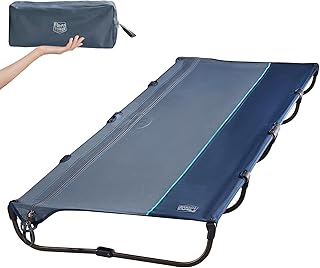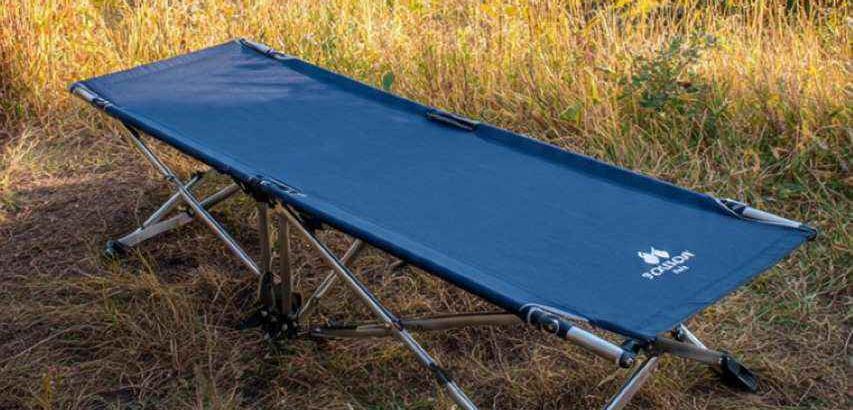A Portable Folding Camping Cot is an elevated sleeping surface designed for outdoor use, providing a stable, comfortable, and insulated alternative to sleeping directly on the ground. It bridges the gap between a minimalist sleeping pad and a full-sized bed, significantly enhancing the camping experience.
Core Components and Materials
Understanding the parts of a cot and what they are made of is key to understanding its performance.
Frame: This is the structural skeleton of the cot.
Materials:
Steel: Most common, known for its strength, durability, and affordability. It is also the heaviest. Often coated with a rust-resistant finish like powder-coating or nickel plating.
Aluminum: Lighter and more resistant to corrosion than steel, making it ideal for backpacking and weight-conscious campers. It is generally more expensive and can have a slightly lower weight capacity than comparable steel frames.
Design: Frames are engineered with pivoting joints and collapsible legs to fold into a compact, portable shape.
Fabric Bed: This is the taut surface you actually lie on.
Materials:
Polyester: The most common choice. It is strong, durable, resistant to mildew and moisture, and relatively inexpensive.
Oxford Nylon: Known for its exceptional strength-to-weight ratio, often used in higher-end or ultralight cots. It has a distinctive textured look.
Ripstop Fabric: Either nylon or polyester woven with a reinforced grid pattern to prevent small tears from spreading.
Coating: The fabric is often coated with a layer of Polyurethane (PU) or Polyvinyl Chloride (PVC) to enhance water resistance and strengthen the fibers.
Support System: This is what prevents the fabric bed from sagging.
Crossbars: Horizontal bars, usually made of steel or aluminum, that slide through sleeves in the fabric. They provide excellent support and distribute weight evenly.
Bungee Cord/Elastic Webbing: An internal system of elastic cords that hold the side rails apart, keeping the fabric taut when the cot is unfolded. Common in simpler, "instant" setup models.
Legs and Feet:
Design: Legs can be simple straight bars or have a "U" or "X" shape for greater stability.
Feet: The ends of the legs are typically capped with plastic or rubber feet. These protect tent floors from scratches, prevent the cot from sinking into soft ground, and add stability.
The Folding and Portability Mechanism
The defining feature of a camping cot is its ability to collapse into a portable package. There are two primary mechanisms:
Scissor-Fold / X-Fold: This is the most classic and common design.
How it Works: The frame is composed of two long side rails connected by multiple legs that pivot in an "X" or scissor pattern.
Process: To fold, you simply lift the cot in the middle, and the ends naturally collapse towards the center, forming a flat, rectangular bundle.
Pros: Very stable, proven design, often more comfortable due to multiple support points.
Cons: Can be slightly bulkier and heavier than telescoping models.
Telescoping / "Instant" Fold:
How it Works: The side rails are composed of concentric tubes that slide into each other (telescope). An internal bungee or hub system often holds the frame open.
Process: To open, you simply pull the ends apart, and the frame "pops" into place. To close, you twist or press release mechanisms to allow the rails to collapse.
Pros: Extremely fast and easy setup (often under 60 seconds), very compact when folded.
Cons: Can be less stable under heavy movement, and the internal bungee systems can wear out over time.
Advantages of Using a Camping Cot
Comfort and Support: Provides a firm, flat surface that is far superior to sleeping on lumpy or rocky ground. It supports your back and hips evenly.
Insulation and Ventilation: Elevating you off the ground provides crucial protection from the cold, as the ground is a major source of heat loss. In hot weather, air circulating underneath can keep you cooler.
Storage and Organization: The space underneath the cot is perfect for storing gear like backpacks, boots, and bins, keeping your tent organized and living space clear.
Durability: Compared to inflatable sleeping pads, cots are less prone to punctures and catastrophic failure.
Ease of Use: Getting in and out of a cot is much easier than getting up from the ground, which is a significant benefit for older campers or those with mobility issues.
Limitations and Considerations
Weight and Packed Size: Cots are almost always heavier and bulkier than inflatable or foam sleeping pads. This makes them less suitable for backpacking, where every ounce counts.
Cost: A quality cot is a more significant investment than a basic sleeping pad.
Requires a Sleeping Pad for Insulation: In cool or cold weather, a cot alone is not enough. The air circulating beneath you will create cold spots. You must use a sleeping pad (or an insulated "cot-topper" mat) on top of the cot to provide dead air space for insulation.
Tent Compatibility: Not all tents have a large enough footprint or a high enough ceiling to accommodate a full-sized cot. Always check your tent's dimensions.
Setup: While generally simple, some cots, especially larger models, can require a bit of strength and dexterity to unfold and lock into place.
Key Selection Criteria
When choosing a camping cot, consider these factors:
Intended Use: Car camping, overlanding, base camp, or emergency preparedness?
Dimensions and Weight Capacity: Ensure it fits your body size (height and shoulder width) and supports your weight.
Packed Size and Weight: Check the length, width, and height of the folded cot to ensure it will fit in your vehicle. Consider the weight if you have to carry it any distance.
Setup Time and Complexity: Look for features like "instant" setup or color-coded components if ease of use is a priority.
Comfort Features: Some cots come with added features like headrests, side pockets, or a more flexible, "spring-like" frame for a plusher feel.
A Portable Folding Camping Cot is a transformative piece of gear for the car camper, festival-goer, or anyone who wants to elevate their outdoor sleeping experience. By providing a comfortable, insulated, and organized platform, it moves the camper away from the inconveniences of the ground and towards a more restful and enjoyable night under the stars. The choice between a robust scissor-fold model and a quick-deploy telescoping cot ultimately depends on the user's specific priorities for comfort, convenience, and portability.
 |  |  |
 |  |  |
